Posted in Blog, Entrepreneurship, Innovation, Intrapreneurship by Jo North
How to Stay Motivated to Achieve Your Goals
Knowing how to stay motivated to achieve your goals will make or break your success. Setting career and business goals can be a wonderfully creative and inspiring process. But goals without actions are only dreams.
It can be hard to get started on your big goal, especially from scratch. And sometimes just as hard work to keep going – especially when life throws you a curve-ball, or your career or business long-term goals seem to be slipping out of reach.
Here are 10 science-based, evidence-backed, practical and easy tips to help you to stay motivated to achieve your professional, career and business goals. They really are some of the best ways to keep your intrinsic motivation driving you forward.
I’ve used all of these tips many times to achieve goals such as:
- Completing my MBA and PhD part-time, whilst working full-time
- Making the transition from a six-figure earning leadership role to starting my own successful company
- Writing and publishing my book, Idea Time
And many more accomplishments and ambitious goals besides!

Jump to links:
- Tip #1: Time – You Have 168 Hours in a Week
- Tip #2 The Essence of Strategy is Deciding What Not To Do
- Tip #3 Get Real About Focus and Distraction
- Tip #4 Understand Your Procrastination Drivers
- Tip #5 Get Clear on Your Game Changers
- Tip #6 Pre-empt the Things Will That Stand In Your Way – Mental Contrasting
- Tip #7 Get Skilled and Confident at Saying “No”
- Tip #8 Beware the Planning Fallacy
- Tip #9 Break Your Game Changer Actions into Micro-actions
- Tip #10 Surround Yourself with a Great Support Squad
Start with a Positive Mindset
To keep motivation alive, it’s crucial to start with the right mindset. Consider this as the first step to achieve your new goals. Develop positive self-talk and foster a positive mindset, which can powerfully alter your nervous system and boost your mental state. External motivators are useful, but avoid negative motivation. Having the right mindset allows for a successful outcome, as it nurtures positive energy and good vibes, which will increase your energy levels.
If you’re at the early stages of setting and working towards your goals, you’ll also find my articles on how to set intentional goals, how to facilitate a goal setting workshop, and growth mindset for goal achievement super helpful. You do need to be super-clear on what your end goal is in the first place, so maybe start with one of those articles first.
Tip #1: Time – You Have 168 Hours in a Week
Time is the one resource that you can’t recreate or get back. Once it’s gone, it’s gone.
We each have 168 hours available to us in every week, no matter who we are.
One of the most common things I hear my coaching, training and consultancy clients say is that they simply don’t have the time to do all the things they want or need to do.
Author Laura Vanderkam strongly disagrees with this contemporary narrative, arguing in her book 168 Hours: You Have More Time Than You Think that 168 hours is enough for a well-balanced, rewarding and healthy career, family and social life without compromising our sleep, leisure time or exercise.
Now if you’re starting to feel a bit grumpy about the idea that you do in fact have more time than you think, at least give some of the ideas and strategies in her book a chance. After all, Vanderkam’s recommendations are based on direct, quantitative research. She studied the time-keeping records of real business leaders to arrive at her conclusions.
Keep Track of Your Time
When we look at how much time we think we spend on an activity versus the reality, our perceptions are usually incorrect.
The human brain is designed to think we spend more time on things we don’t like doing, that bore or stress us, or that we find very tough, than we actually do. The opposite is true for things we enjoy doing – time seems to fly by, and we remember the duration less well.
Tracking your time for a couple of weeks will give you a more objective view of how you spend your time in reality, rather than relying on how you think you spend your time.
I use the Toggl app to do this. It’s super easy, with a free version. If you choose to pay for more bells and whistles it’s still really inexpensive. You simply select the task and hit ‘start’ when you begin and activity and ‘finish’ when you end it. Toggl will do all the analysis for you, and show you super clearly exactly how you’re investing your time.
Use Your Time Tracking to Be More Intentional with Your Time
You can then use the insights from your time tracking to make intentional adjustments to how you are spending your time. You’ll find more of the space you need to work consistently towards your big goals. Carving out dedicated opportunities in this way will help you to stay motivated to achieve your goals.
Vanderkam’s study showed that many of us spend ‘busy time’ on low value, low priority activities. We could invest that time better in other things, strengthening our momentum and positive motivation.
Balance Your Professional and Personal Goals
For all human beings, balancing personal goals with professional ones is a crucial, yet often overlooked, aspect of everyday life. Incorporate different things such as social events and even a few minutes of exercise into your schedule to enhance your mental health. Also, remember that each day is a new opportunity for progress, so set goals for every single day.
Tip #2 The Essence of Strategy is Deciding What Not To Do
“The essence of strategy is deciding what not to do” is a great quote by leadership expert Michael Porter.
It’s also echoed in the premise of one of my favorite books, Four Thousand Weeks by Oliver Burkeman. If we live to the age of 80, we will have four thousand weeks in our lifetime. This is a short amount given the history of the planet. We will never be able to do all the things we want to do in that lifetime. So, Burkeman recommends that we make intentional choices about what we will choose not to do.
Now, I know that in tip #1 I said that we have more time than we think. That’s still true. We have more time than we think, yet still not enough time to do everything! We can usually make much better use of the time we have.
Burkeman’s advice isn’t about ramming that time with high productivity activities, striving to achieve as much as you can, however. He recommends that you embrace your limitations. You will never be able to do it all. By confronting this, you can begin to focus on what matters.
If you have taken steps to ensure that you’ve set your career and business goals with intention, this advice helps. It enables you to cut away the things that would be nice to do, but that matter less. This will give you more space, energy and motivation to achieve your goals.
Getting clear on your real priorities and focusing on those is key for you to stay motivated to achieve your goals.
Tip #3 Get Real About Focus and Distraction
In 1925, Hugo Gernsback invented the ‘Isolator’, which was “A Helmet For Insulating The Senses Against Distraction”. (The Journal Science And Invention, Vol. 13, No. 3, July 1925).
Even back then, before the age of social media and video games, Gernsback found it hard to focus. He wanted to do what Cal Newport just a few years ago referred to as “Deep Work“. Gernsback’s helment invention was an attempt to block out external distractions so that he could concentrate better and for longer.
But, as Gernsback soon learned, external factors are only around half the problem when it comes to preventing focused work. He observed back in 1925 what Killingsworth & Gilbert, Harvard University later corroborated through research. That is, we spend about 47% of our waking hours thinking about something other than what we’re currently doing.
Maybe you sometimes get yourself ready to work on your goal, only to be distracted by something else? An email pings in, you take a call, you do a quick check of your social media… And before you know it, the time has been gobbled up on other stuff?
There is increasing evidence to show that using mindfulness techniques and practising meditation can help you to focus, stay motivated and achieve your goals.
Practise Getting into Flow
My own preferred technique is to get myself into what Mihaly Csikszentmihalyi called a state of flow. This is when I’m stretching myself to achieve a task or complete an activity, using lots of skill. It means that I have to focus.
This is that wonderful experience of being so engrossed in what you’re doing, that you lose track of time. It seems to stand still. You feel like you carry on forever, almost, and not even notice the time passing.
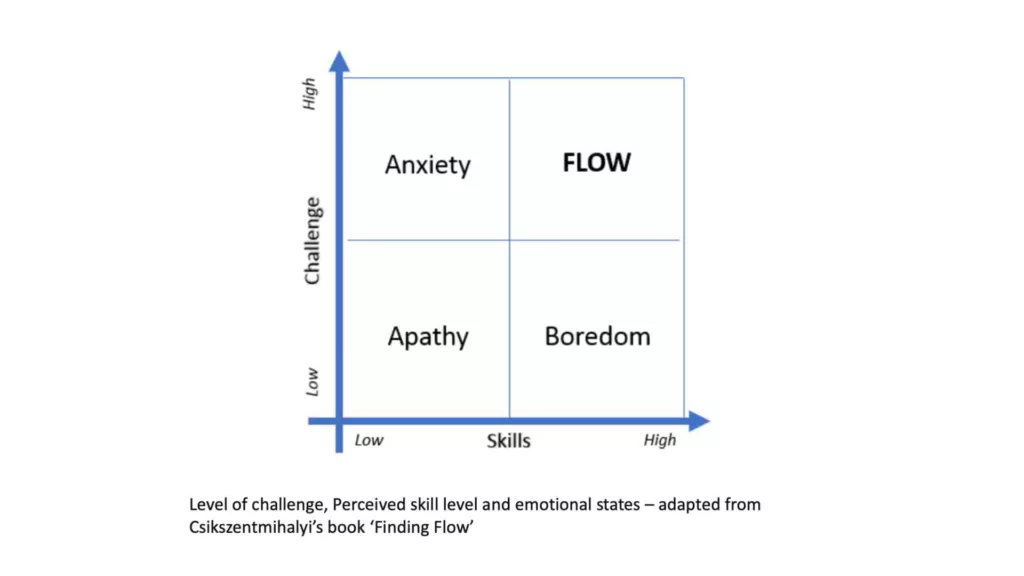
To get into flow, decide on a challenge related to your career or business goal that you want to accomplish. It needs to be one that you have the skills to achieve, but it will take effort and some concentration.
Locate yourself in a productive setting. Somewhere comfortable and with the minimum external distractions.
Adopt the mindset of looking forward to the challenge – then get started.
If you wind up feeling bored, increase the challenge.
If you start to feel anxious, tap into your skill.
To counter a lack of enthusiasm, up the difficulty of the challenge and the level of skill needed.
Knowing how to get yourself into flow will help you to stay motivated and achieve your goals. It will make your journey towards your goals more enjoyable. You’ll also see great progress and personal growth, which will spur you on.
Use a Vision Board to Stay Motivated and Achieve Your Goals
A vision board, also known as a dream board or a goal board, is a physical or digital tool used to visualize and focus on your life goals and aspirations. It is essentially a collage of images, pictures, affirmations, quotes, and other elements that represent whatever you want to be, do, or have in your life.
The images and words chosen for the vision board serve as tangible representations of your dreams and goals. They could be related to your career aspirations, personal growth, financial prosperity, health goals, relationships, travel, or any other area of your life where you desire improvement or achievement.
In the context of business and professional goals, a vision board can be especially valuable. For example, if you’re an entrepreneur or a startup founder, your vision board might include images or symbols representing the growth of your company, the expansion of your team, successful product launches, meaningful partnerships, or achieving a certain revenue goal.

It can serve as a visual representation of your goals and aspirations, serving to program your subconscious mind towards a positive direction.
the images and ideas we focus on the most are the ones we subconsciously work towards and attract into our lives. By placing your vision board in a place where you see it daily, you’re likely to do more to achieve those goals, even subconsciously.
How Vision Boards Work
Vision boards work in several ways:
- Clarity: Creating a vision board forces you to become clear about your business and professional goals. It compels you to think about what success looks like for you.
- Visualization: A vision board serves as a constant, visual reminder of your goals and aspirations. The act of visualizing your success can boost your confidence and motivation to work towards your goals.
- Inspiration and Motivation: Seeing your goals visually every day can serve as a powerful source of inspiration and motivation. It helps to keep your ambitions at the forefront of your mind, driving you to take steps towards them.
- Reinforces Positive Thinking: A vision board filled with positive images and words can help to promote a positive mindset, essential for overcoming challenges and setbacks that may come your way.
- Encourages Action: Every time you look at your board, you’re reminded of where you want to go, which can spur you to take action towards achieving your goals.
A vision board can play a significant role in helping you stay focused on and motivated towards achieving your big business and professional goals. It’s a tool that brings your ambitions to life, making them more tangible and real.
Tip #4 Understand Your Procrastination Drivers
Procrastination can be demotivating, and obviously gets in the way of you smashing your big career and business goals.
The word ‘procrastination’ comes from the Latin for putting things off until tomorrow.
And it’s not usually a symptom of laziness.
By understanding the potential root cause behind your own procrastination, you can use intentional strategies to work with it.
Main Reasons for Procrastination
Here are some of the main reasons for procrastination.
Present Bias:
As humans, we often have present bias. This means that we prioritize immediate gratification over long-term rewards.
Perfectionism:
Perfectionism, or the fear of making mistakes, can lead to avoidance of tasks. You want to do the task really well, and it’s important to you. But the fear of failure and not doing it well enough puts you off getting started.
Overwhelm:
Large tasks can seem daunting, causing you to delay starting. Sometimes, you might not know where to start.
Lack of Motivation:
If a task isn’t personally meaningful or rewarding, you’re more likely to put it off.
Decision Fatigue:
Too many choices or decisions can lead to avoidance of making any decision at all.
Task Aversion:
If you see a task as boring or unpleasant, you’re more likely to procrastinate on it.
Low Self-Efficacy:
Self-efficacy is your belief in your ability to complete a task. If you doubt your ability to complete a task, you’re more likely to delay it.
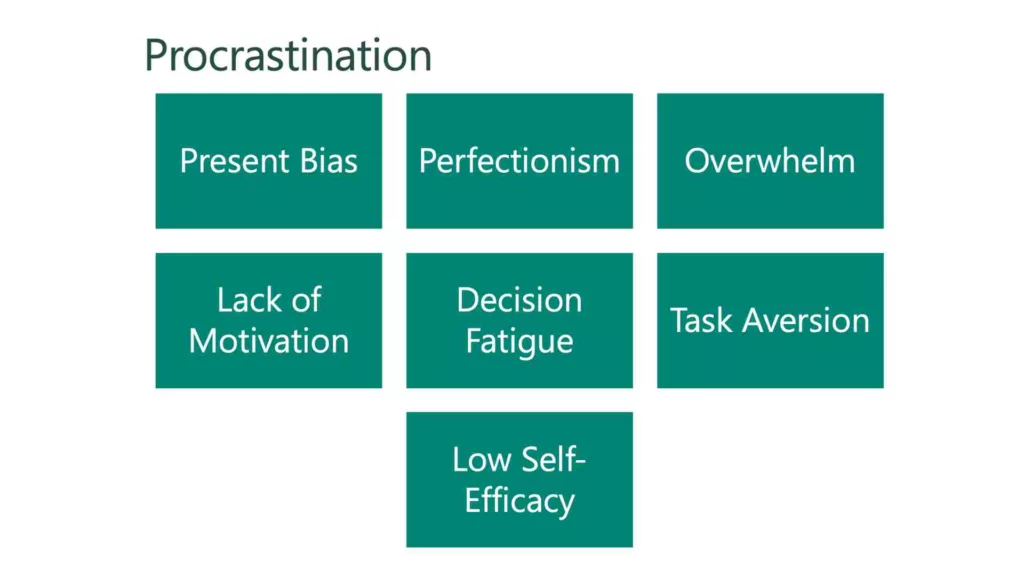
Strategies to Combat the Causes of Procrastination
Here are evidence-based strategies to combat each of the causes of procrastination:
Present Bias:
Use “temptation bundling,” i.e. pair a task you’re avoiding with something you enjoy doing, to make it more appealing.
Perfectionism:
Embrace a growth mindset, focusing on learning and improving rather than being perfect. Practice self-compassion to help alleviate fears of making mistakes.
Overwhelm:
Break tasks into smaller, more manageable parts. This approach, known as “chunking,” makes tasks seem less daunting.
If you don’t know where to start, randomly pick something to do and start there.
Lack of Motivation:
Connect tasks to your larger goals and values to make them feel more personally meaningful. Hopefully, you’ve done this with your intentional goal setting activities. If not, now’s the best time to do it.
Decision Fatigue:
Limit the number of choices you have to make in a day, streamline decisions where possible. Make important decisions earlier in the day when your mental energy is higher.
Task Aversion:
Use techniques like the “Pomodoro Technique.” This is where you work on a task for a set amount of time (e.g., 25 minutes). Then, take a short break. It can make an unpleasant task more bearable.
Low Self-Efficacy:
Build self-efficacy through setting and achieving smaller goals, seeking support and feedback, and visualizing success.
Tip #5 Get Clear on Your Game Changers
A Game Changer is an action, task, or strategy that makes a significant impact toward the achievement of your goal.
To identify your Game Changers:
- List all the potential actions you think you could take to achieve your goal
- Evaluate the potential impact and effort of each of those actions
- Prioritize them – the high impact actions are your Game Changers. The low effort, high impact Game Changers are your quick wins. The high effort, high impact Game Changers are your future stars.
- As you work through the priority actions, measure and adjust as you learn more and get closer to your goal.
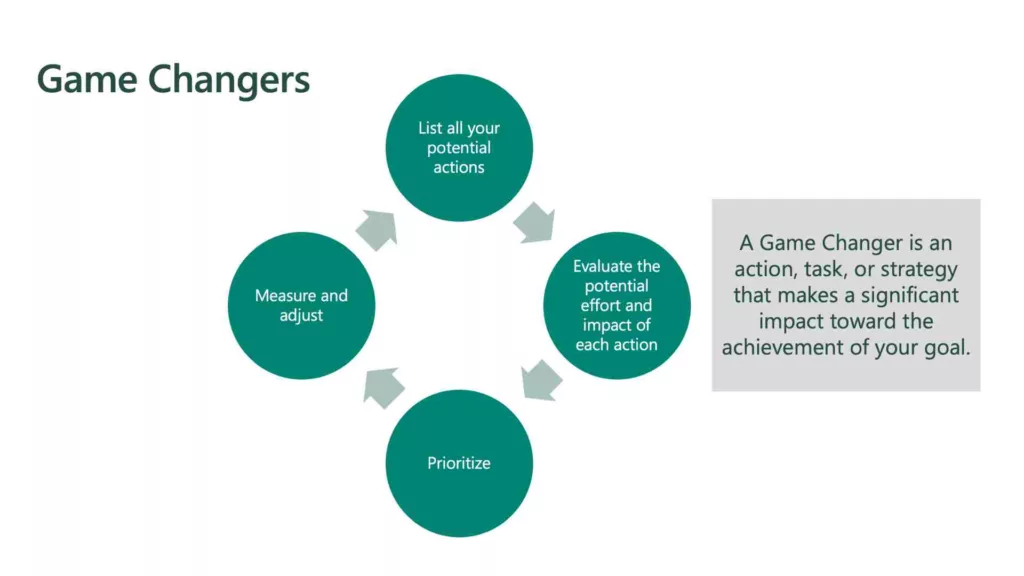
Tip #6 Pre-empt the Things Will That Stand In Your Way – Mental Contrasting
Facing brick walls is a part of the journey. The important part is to keep going. Persistence – also known as grit – is an important factor. Sometimes, the third time is the charm. Maintaining fitness goals, for instance, can be a real challenge when you’ve got a lot going on at work, but with the right attitude and a little bit of perseverance, you can overcome any obstacle.
Mental Contrasting is what Gabrielle Oettingen calls the skill of pre-empting the things that will stand in your way.
To stay motivated and achieve your big career and business goals, there will be numerous challenges and hurdles ahead. If your goals were easy and straightforward, they wouldn’t be big goals!
Gabrielle Oettingen recommends that you use the WOOP technique to identify potential blockers, and create a plan before they happen. This is so that you’re ready for them with your plan when they do pop up.
WOOP stands for:
- Wish. Which goal do you want to achieve? Make some notes about it.
- Outcome. How will it feel when you reach your goal? Take some time to imagine it.
- Obstacle. What are your main obstacles? Write them down.
- Plan. Make a plan for how you will tackle each of the obstacles, if and when they happen. Write these plans down.
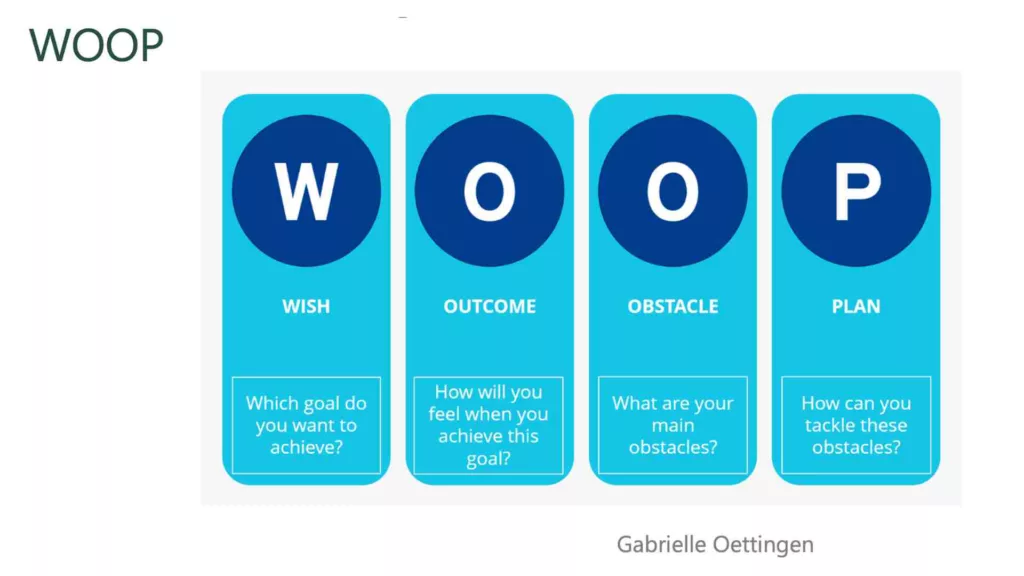
Research shows that people who use the WOOP mental contrasting technique have more success in making sure they stay motivated to achieve their goals.
Tip #7 Get Skilled and Confident at Saying “No”
To create the time and capacity you need to achieve your big career and business goals, you’ll need to get skilled and confident at saying “no”. Even better, if you can pre-empt and plan for some of the situations where you know you’ll need to say “no”, using mental contrasting, you’re likely to have even greater success.
Present bias can often mean that we say “yes” to people because we don’t want to feel uncomfortable in the moment. Even when we know that we have neither the time nor the inclination to do what the other person is asking.
So getting ready with strategies to help you say “no”, in the right way, when you need to, will be a big help.
Here are some tips on how to say “no” without damaging your relationships or reputation:
Don’t Respond Immediately
Remember that you usually don’t have to answer straightaway. Don’t say no until you’re sure you need to. The important thing is that you don’t impulsively say “yes” in the moment. Use words such as:“Leave it with me, I’ll need to have a look at current commitments. I’ll get back to you.” These will give some time and space to reflect and respond appropriately.
Consider Potentially Acceptable Reasons for Saying “No”
When you’re saying “no”, you don’t always have to give a reason or explain yourself. But sometimes at work it can be helpful to do so. Feeling that you have a valid reason for saying “no” will also make you feel more confident and comfortable with it.
Some examples of potentially good reasons are:
•The timeframe doesn’t work – eg unachievable deadlines
•You’ll have to neglect other important work
•It’s not within your skillset or professional development plans
And ask yourself:
•Am I the only person who can do this?
•Will this project move me closer to achieving my top priorities and longer-term goals?
•If I don’t do this, will it matter in a week, a month, or a year from now?
If you answer any of these questions in the negative, a strategic ‘no’ is likely in order.
Practise saying “no” in low risk, low stakes situations and build up from there
Practise saying “no” in low risk, low stakes situations is a great way to build your skill confidence. If you’re usually the person in a group who goes with the flow on choice of restaurant or film to watch, start stating a preference, for example. Then build from there.
Tip #8 Beware the Planning Fallacy
To stay motivated and achieve your goals you need to be realistic about how long things will take. Optimism is awesome, but expecting overnight success usually isn’t practical or realistic.
The Planning Fallacy is a cognitive bias that leads us to consistently underestimate timelines, despite knowing that similar tasks have taken longer in the past. This prediction bias springs from our sense of optimism, but events don’t usually unfold as we imagine. Instead, we tend to run into unexpected obstacles, delays, and interruptions.
To limit the effects of this mental error, add a buffer of 20% into your plans for achieving your goals, and when planning for your other work, to be pragmatically realistic about your time management and productivity.
Tip #9 Break Your Game Changer Actions into Micro-actions
Break your Game Changer actions down into micro-actions.
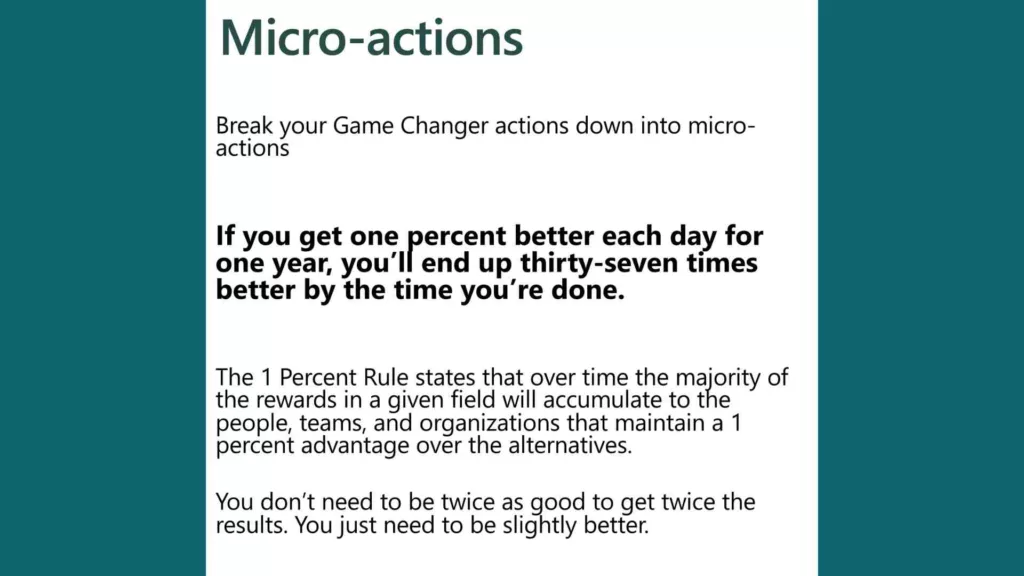
Setting new goals is only the beginning. To go a long way in reaching them, you need to break them down into smaller pieces or smaller chunks. This method makes your big dreams seem more manageable. Instead of focusing solely on the end result, concentrate on the smaller steps that lead there. This can act as a great motivator and is one of the key ingredients to maintaining momentum. An action plan broken down into smaller parts will not only give you a good start, but also ensure you’re well-positioned for the long run.
If you get one percent better each day for one year, you’ll end up thirty-seven times better by the time you’re done.
The 1 Percent Rule states that over time the majority of the rewards in a given field will accumulate to the people, teams, and organizations that maintain a 1 percent advantage over the alternatives.
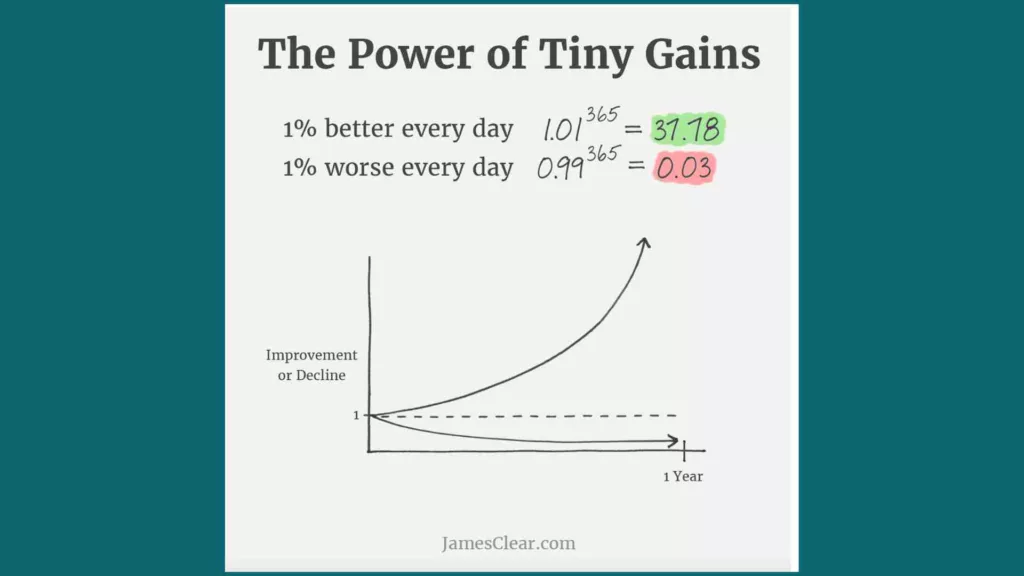
You don’t need to be twice as good to get twice the results. You just need to be slightly better.
Consider SMART Goals
Consider SMART goals (Specific, Measurable, Achievable, Relevant, Time-bound) as they are a good way to refine your objectives. If you are a startup founder, aiming for a new job or looking to acquire new skills, SMART goals can be helpful. Moreover, set aside time in your daily routines to work on these goals. It’s important to schedule time for this task on a regular basis. An online forum or online courses can provide support and further skills development.
Tip #10 Surround Yourself with a Great Support Squad
Be intentional about the people you call on to support you on your journey towards achieving your big goals. Shape a great support squad. Ideally your support squad will feature people who will perform the following roles for you. Bear in mind that one person can perform more than one role. They may or may not have similar goals to yours. The important thing is that you surround yourself with positive people. Successful people, like-minded individuals who will help you find effective ways to make progress towards your ambitious goals.
Goal Achievement Support Squad Roles
- Sounding board
- Network connector
- Voice of experience
- Idea generator
- Devil’s advocate
- Whip cracker
- Motivator / cheerleader
- Expert
The importance of a support network or support system should not be underestimated. Whether it’s a best friend, a mentor, or a group of like-minded individuals in an online forum, these networks provide different ways to stay motivated.
Also consider how you can pay it forward, and think about what role(s) you can play in helping others to stay motivated and achieve their goals too. It would be great if you could share this article and these tips with them!
Next Steps to Stay Motivated and Achieve Your Goals
Achieving goals is not always about a straight path or an uncertain reward. It’s about finding a balance in your professional goals and personal life, and understanding the bigger picture. Through this process, you can gain new skills and insights that can be applied to different areas of your life. Keep in mind that small steps lead to big changes.
Remember to enjoy the journey towards your goals, expect and plan for likely challenges, use these tips and strengthen your own skills by helping – or even mentoring and coaching – others.
“It always seems impossible until it’s done.”
– Nelson Mandela
When you look back on the work you did to achieve your goals, you’ll see just how much you’ve learned, grown and accomplished.
If you’d like any support with intentional goal setting and achievement, do check out my Power Hour one-to-one coaching option. I’d love to help you to accomplish the career, professional and business goals that are meaningful to you.

